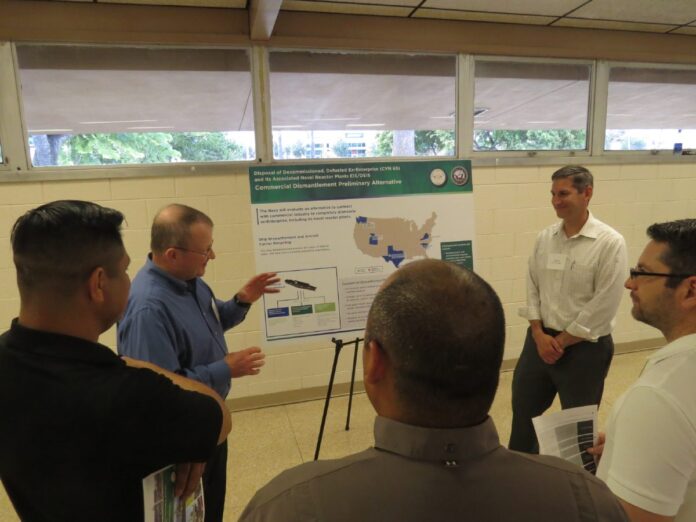BROWNSVILLE — It’ll be a few years before the world’s first nuclear-powered aircraft carrier comes to Brownsville for dismantling, if it happens at all.
That’s according to Jeff Avery, director of Regulatory Affairs for Naval Reactors, interviewed during a public meeting this past week hosted by a team from the Department of the Navy and held at the Fort Brown Memorial Center.
The purpose of the “scoping meeting” was to provide information, answer questions and gather public input regarding the Navy’s project to dispose of the retired USS Enterprise (CVN-65) aircraft carrier, which could wind up at International Shipbreaking/EMR Group at the Port of Brownsville.
The meeting was an early step in the process of preparing an Environmental Impact Statement for project alternatives as required by the National Environmental Policy Act, since it involves a nuclear-powered warship. Similar meetings are taking place this month at three other potential sites, one in Virginia and two in Washington State.
Avery said the Navy will combine the results of the EIS with an analysis of costs associated with each alternative for disposing of the ex-Enterprise, though no final decision will be made until a “record of decision” is issued for the EIS, which won’t happen before 2022.
“It’s an important analysis and there are a lot of things that need to come together to support the Navy’s decision-making process,” he said.
Avery said the vessel’s eight reactors have already been defueled and the nuclear material sent to a storage site in Idaho.
“That removed over 99 percent of the radioactivity from the ship,” he said. “What’s left is characterized per federal requirements as low-level radioactivity.”
Avery said the Navy has successfully and safely conducted 133 reactor-disposal projects on 124 ships since 1986. The world’s first nuclear-powered warship was the USS Nautilus submarine, launched by the Navy in 1954 and decommissioned in 1980.
“I think it’s important for the public to understand that safety and environmental stewardship are really our top priority, and our nuclear-powered warships have operated safely since Nautilus, our first (nuclear-powered) submarine, went to sea,” he said. The Enterprise, commissioned in 1961 and deactivated in 2012, is currently moored at Newport News, Va., where it was built. The Navy had planned to have the carrier towed to and dismantled at the Puget Sound Naval Shipyard in Bremerton, Wash., but then identified preliminary alternatives, including Brownsville.
“There’s really a couple of different reasons,” Avery said. “One is we think there may be some compelling cost and schedule advantages with some different options. But the other is, this may be a way for us to better utilize Puget Sound Naval Shipyard resources for their current mission sets, including active fleet support. It’s very busy and we expect that the shipyard’s going to be very busy for the foreseeable future.”
The work of dismantling the carrier will involve building enormous containers for its eight reactor compartments, though the backlog at Puget Sound means that work probably wouldn’t get underway until the 2030s, he said.
“There may be some difference in overall project cost and span, so not only when you begin, but how long the project takes once you’ve begun,” Avery said. “We have to take a look at all of that.”
The Brownsville option presents two possible scenarios: One is that entire vessel is dismantled by International Shipbreaking/EMR Group, with the reactor plants being disassembled, encased and shipped by road or rail to a licensed radioactive disposal site. The other is that the center section of ship containing the reactors is removed, loaded aboard a “heavy lift ship” and transported to Puget Sound for reactor packaging.
Robert Berry, vice president of International Shipbreaking/EMR Group, who attended Thursday’s meeting, said that either way the company is prepared to take on the ex-Enterprise, though he doesn’t expect a Request for Proposals from the Navy until late 2021, after a draft EIS has been issued, after which another public comment period will take place.
“Brownsville can do it safely,” he said. “We’ve done five carriers and three in my yard alone. We know what we can do. We know the hull.”
Submitting comments
Comments may be submitted through July 15 online at carrierdisposaleis.com, or mailed to Puget Sound Naval Shipyard and Intermediate Maintenance Facility, 1400 Farragut Ave., Bremerton, WA 98314–5001, Attn: Kellie M. Randall, Public Affairs Officer, CVN65 EIS.




